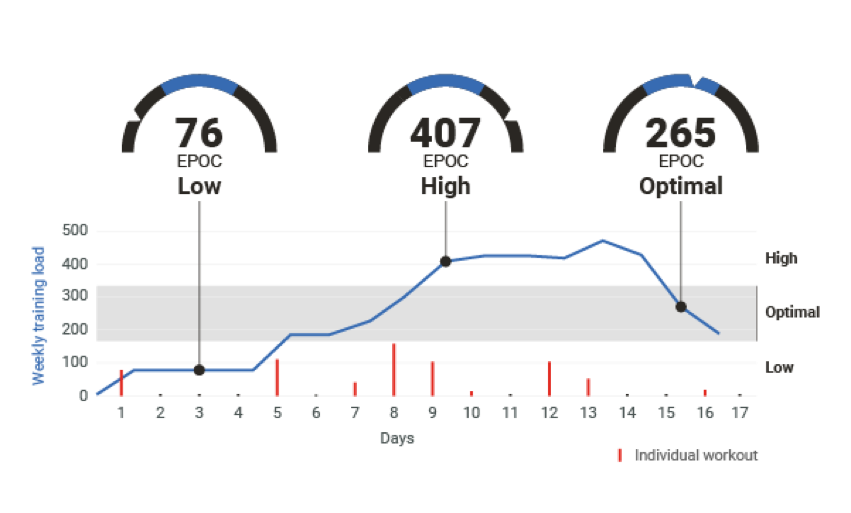What’s the Deal with Training Loads? Discover Your Body’s Secret Language
There isn’t one specific route to boosting your performance capacity. That’s one fact that the experts can agree on. Rather than finding a single universal master plan, you simply need to understand and apply a variety of well-known training principles, experimenting and learning what works best for you along the way.
One of the most essential principles to understand is the overload principle. It simply describes the fact that performance gains result from the application of sufficiently challenging training loads.

In the weight room, it’s obvious. To get stronger, you lift heavier weights, add reps, or sometimes both depending on the type of strength you want to build. Put too much weight on the bar before you are strong enough and you risk getting crushed or injured.
When it comes to improving your aerobic fitness level (VO2max), race times, and other dimensions of capacity and achievement linked to cardiorespiratory performance, the overload principle is in full effect, but applying good management practices is a bit trickier.
Not every load is as easy to see as the lbs./kgs engraved on the side of a dumbbell, and as they say in business school, measurement is an essential component of efficient and effective management strategies.
There are many ways to quantify or measure physical activity. The whats and hows of measurement define what you can do with the data you collect. You could think about the type of activity. Am I running, cycling, or attending an aerobics class? You could track distance. Good for running or cycling, but less helpful for running and cycling, and of course, completely unhelpful for tracking the impact of your aerobics class.
The question we are really trying to answer is this: how much restorative and adaptive work will my body need to perform because of my activities? In other words… what is the physiological impact of my activities on my body? What’s my Training Load?
It’s the metric that makes it possible to bring a 5k interval session, a 10k tempo run, a 22k long run, a kettlebell workout, a cycling trip, or a visit to your local CrossFit or aerobics studio together. It gives you the ability to capture a multitude of different activities from the same perspective, the perspective that matters.
Most experienced athletes tend to have a good sense of where their body is from a loading perspective. This type of body awareness is honed over the course of years, sometimes decades, of training exposures and experiences. Even then, prolonged exposure to high training loads can distort the true degree of exposure.
For younger athletes and others without the insights gained through of years of intensive training experience, Training Load data serves as a powerful ally and tool in the development of body awareness. It makes various exertions tangible and easy to locate, providing context for the complex sensation of training experiences.
Listening to your body doesn’t help if you don’t share a common language.
Managing your training load isn’t just about producing performance gains. Top sports scientists are increasingly utilizing this information to reduce injury risks. It’s easy to assume that high training loads equal greater chance of injury.
If you don’t want sport injuries, don’t do sports, right? Not quite.
Increasing evidence points to the fact that higher training loads, alone, are not linked to increased injury incidents. In fact, the benefits of hard training – better fitness, strength, coordination, neurological factors, etc. – all reduce injury risks. The critical aspect lies in week-to-week changes in training load. One study revealed that a whopping 40% of athlete injuries were associated with a rapid increase in training load during the previous week.
You can create a sweet spot for reduced injury risk by managing your training load so that week-to-week changes are kept roughly in the range of 80% and 130% of the previous week. Looking back at your own Training Load data it’s easy to pick out the important trends to gain insight into your own risk exposure.
You can also be proactive, look forward, and use this same information to ensure that your future plans aren’t radically bumping your Training Load upwards, throwing your ratios out of whack and increasing your chances of becoming injured.
Ultimately, re-understanding your activities in terms of the load they place on your body is a big deal. You can ensure you are challenging hard enough to reach your goals, you can navigate around potential injury risks, you can even look at very different kinds of activities through the same lens. It’s worth the effort.
The post What’s the Deal with Training Loads? Discover Your Body’s Secret Language appeared first on Garmin Blog.
Sample Block Quote
Praesent vestibulum congue tellus at fringilla. Curabitur vitae semper sem, eu convallis est. Cras felis nunc commodo loremous convallis vitae interdum non nisl. Maecenas ac est sit amet augue pharetra convallis nec danos.
Sample Paragraph Text
Praesent vestibulum congue tellus at fringilla. Curabitur vitae semper sem, eu convallis est. Cras felis nunc commodo eu convallis vitae interdum non nisl. Maecenas ac est sit amet augue pharetra convallis nec danos dui.
Cras suscipit quam et turpis eleifend vitae malesuada magna congue. Damus id ullamcorper neque. Sed vitae mi a mi pretium aliquet ac sed elitos. Pellentesque nulla eros accumsan quis justo at tincidunt lobortis denimes loremous. Suspendisse vestibulum lectus in lectus volutpat, ut dapibus purus pulvinar. Vestibulum sit amet auctor ipsum.

